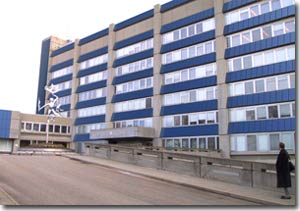
Image: Solar Design Assciates
 |
An artisit's
rendition of what the final BIPV project should look like. Image: Solar Design Assciates |
"There is no better place to showcase U.S. technologies and to
demonstrate international cooperation on green energy than in Geneva, a highly
visible diplomatic center and the site of hundreds of international meetings
each year."
- Solar Design President Steven Strong
| Geneva,
Switzerland - May 25, 2004 - [SolarAccess.com] The U.S. Mission to
the United Nations in Geneva is set to become the first United States
diplomatic building with a building-integrated solar electric (BIPV)
system. Over the coming months, the U.S. Mission's facade and roof will
be fitted with solar photovoltaic (PV) panels. The electricity generated
by the 118 kW PV system will provide power for the Mission while any
surplus generation will be fed into Geneva's electric power grid. The project is the result of a Swiss and American public-private sector partnership initiated by Ambassador Kevin E. Moley, the U.S. Ambassador to the United Nations in Geneva. The partnership brings together the U.S. Mission, Geneva's Service Cantonal de Energie (ScanE) and the Services Industriels de Geneve (SIG). Construction is set to begin in mid-summer 2004 and the green energy system should be operational this year. Solar Design Associates, Inc. of Harvard, Massachusetts provided design and engineering services for the seven solar electric systems on the Mission and will oversee their installation. Solar Design President Steven Strong described the project as, "a significant initiative by the State Department to embrace solar energy and sustainable design," Strong said the solar electric sunshades integrated on the building's facade will provide multiple benefits to the Mission, delivering cooling load mitigation and glare control while generating decades of renewable electricity. "It is a privilege to help our country showcase American-made green technology on this landmark project in Geneva," Strong said. "There is no better place to showcase U.S. technologies and to demonstrate international cooperation on green energy than in Geneva, a highly visible diplomatic center and the site of hundreds of international meetings each year." Charles E. Williams, Director and Chief Operating Officer of the State Department's Overseas Buildings Operations Office (OBO), describes the project at the U.S. Mission in Geneva as OBO's flagship green energy project for 2004. The Geneva project is the first significant building-integrated photovoltaic project (BIPV) ever implemented at a U.S. diplomatic post. This project will put the U.S. Mission at the cutting edge in an effort to make U.S. Embassies worldwide greener and more self-sufficient. In addition these types of projects can also increase energy security at U.S. facilities worldwide. "In the future, photovoltaic technologies can prove particularly useful at embassies in regions of the world where sun is plentiful and power reliability is low," said OBO Engineer Mike Christensen. State Department Project Architect Ronald J. Tomasso noted that the project will also enhance the external appearance of the U.S. Mission building. The attractive crystalline blue arrays used to harvest energy from the sun will be mounted on the facade as sunshades running above each row of windows and on the roof of the building. The PV panels used for the project are produced by in the United States, but bidding on the construction project has been opened to contractors from other countries and will be awarded to the lowest bidding responsible and responsive contractor. On a sunny day the system at the U.S. Mission will deliver a peak-power of up to 118 kW and generate enough energy annually to power 40 - 50 average households. In addition, since the panels will reduce heat gain in the building's glazing, facades and roof, they will also reduce air conditioning requirements thereby lowering electric energy consumption. |
|
|
| For
Further Information: • Solar Design Associates Please Note: SolarAccess.com and Arizonaenergy.org do not endorse the sites behind these links. We offer them for your additional research. Following these links will open a new browser window. |
Copyright © 1999 - 2004 - SolarAccess.com
Please visit www.solaraccess.com for more great news and information on what's happening in SOLAR!!